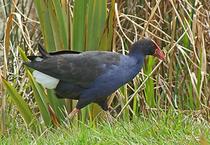The New Zealand native Pukeko (Porphyrio melanotus) is a large, blue-purplish, wetland-dwelling bird.
 Pukeko are held in rueful affection by New Zealanders, with a reputation as a friendly, cheeky bird, they are very territorial. They are often nicknamed “swamp hen”, “pook” or to some hunters, the “blue pheasant”.
Pukeko are held in rueful affection by New Zealanders, with a reputation as a friendly, cheeky bird, they are very territorial. They are often nicknamed “swamp hen”, “pook” or to some hunters, the “blue pheasant”.
The Pukeko is a member of the rail family of birds and most people will notice the very strong similarity between the pukeko and the endangered takahe. These types of birds are common throughout the Pacific. The form melanotus breeds in northern and eastern Australia, Tasmania and New Zealand, including the Kermadec and Chatham Islands. They, like paradise shelduck and the Canada goose have benefited from land clearance and the development of land for pasture and for crops and market gardening. They have also adapted well to urbanisation.
Pukeko behaviour
The pukeko is a great wader and runner. When disturbed they much prefer to run or hide than to fly. However when pushed, they are strong fliers and can fly long distances if needed. Pukeko lack webbed feet, but are good swimmers and have good balance in water, on land or in trees. While they look very attractive in the wild, they are in fact quite aggressive and will attack, the chicks of other species in particular. The culling of pukeko on Great Barrier Island by the Department of Conservation has been a major part of the programme to restore the population of little brown teal.
Hunting pukeko
Pukeko have been harvested in New Zealand for generations. The blue body feathers are prime fly-tying feathers for classic night lures such as the Craig’s Night-time, Taihape Tickler and Scotch Poacher among others. Many Maori cloak weavers are also very keen to access pukeko feathers. They are underrated as table fare and can be delicious in casseroles and patties.
Pukeko have good hearing and eyesight, and can be very challenging to hunt once they wise up to hunting. However, in dim light or high winds they are easier to approach. Another exciting technique is to flush them from raupo swamps using a good dog.
Where to find pooks
Pukeko population numbers vary in different parts of the country and there is a lower daily bag limit in some regions, such as North Canterbury. In other regions, with higher rainfall and lower lying areas, pukeko numbers are higher and the bag limit is also higher (West Coast bag limit is 20).
In some of these regions their numbers are having an adverse effect on agriculture. In response to reports of damage to crops and horticulture in the West Coast and Nelson/Marlborough Fish & Game regions for example, special seasons have been successfully used to disperse birds from sites and reduce population numbers through a harvest outside of the main open game season.
On the West Coast of the South Island, a significant increase in the total area of improved pasture throughout much of the region has led to pukeko populations becoming more widely distributed, with large concentrations of up to 200 to 300 birds now common on properties where the habitat is especially favourable.
Since 2000, Fish & Game has monitored pukeko in this region using a combination of roadside transects and static counts. In the region annual fluctuations at monitoring sites are common due to a tendency for flocks to be quite mobile. The long-term trend, however, shows the overall West Coast population has averaged 3% growth per annum.